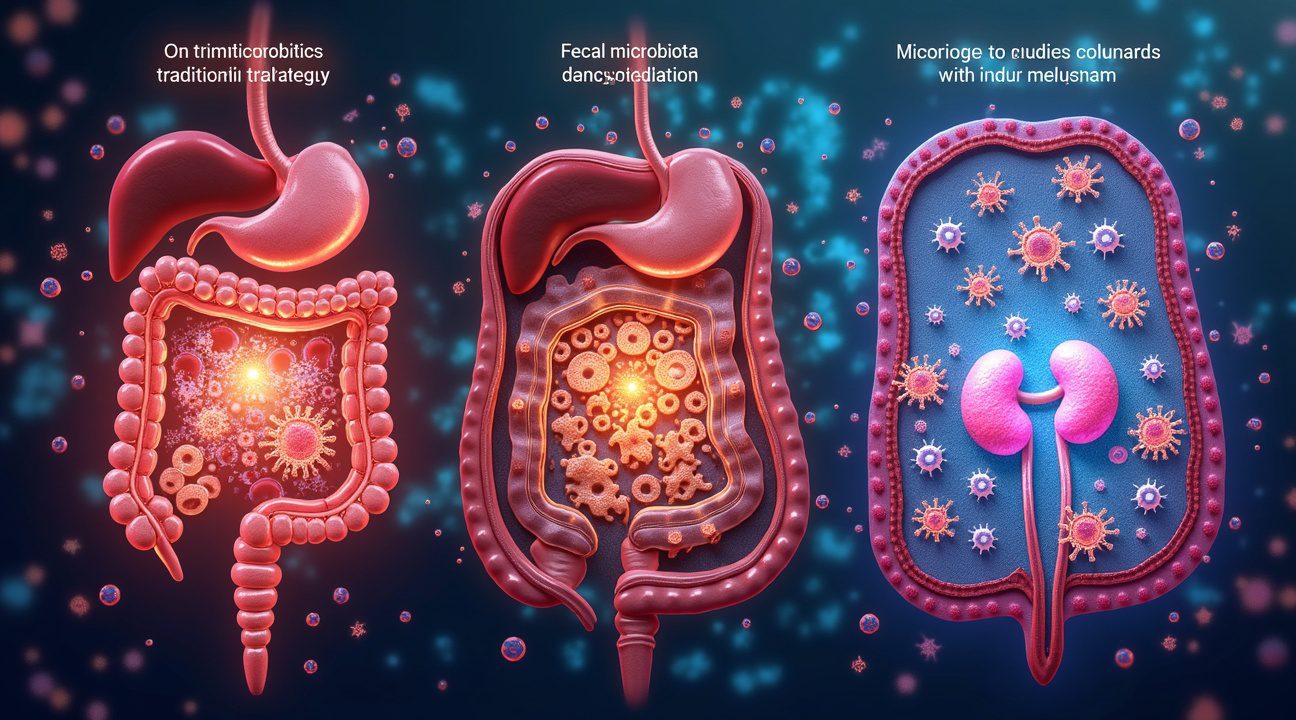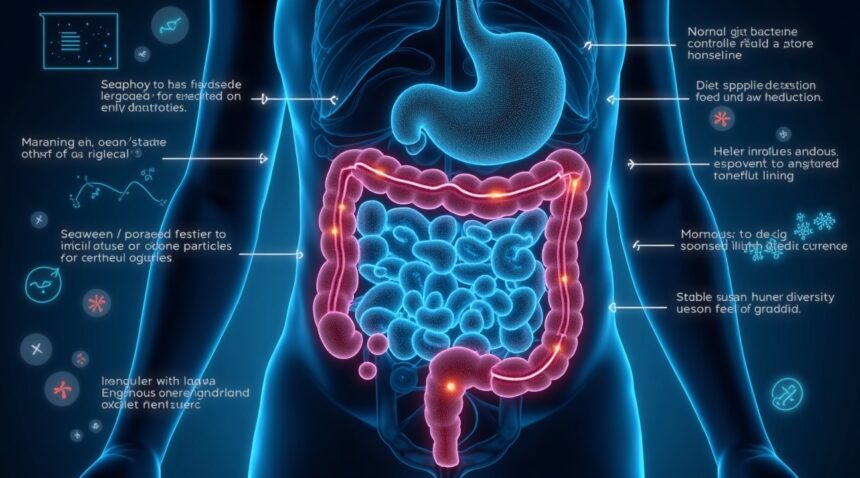Scientists have successfully developed genetically modified gut bacteria that can safely break down kidney stones inside the human body, offering a revolutionary approach to preventing these painful formations.
Clinical trials involving 19 volunteers demonstrated that these engineered bacteria can effectively colonize the gut and reduce urinary oxalate levels—a key marker for kidney stone risk—while maintaining excellent safety profiles with no serious adverse events reported. This innovation represents a significant leap in the domain of precision microbiome therapy.
Key Takeaways
- Engineered gut bacteria successfully reduced urinary oxalate levels in human trials with dose-dependent effectiveness, allowing doctors to customize treatment intensity based on individual patient needs.
- The treatment offers controllable colonization through dietary porphyran consumption, enabling patients to manage the bacteria’s presence and making the therapy reversible in most cases.
- Modified bacteria create a synthetic ecological niche that doesn’t disrupt existing gut microbiome diversity, addressing major safety concerns with bacterial interventions.
- The approach targets the root cause of kidney stone formation by breaking down oxalate into harmless compounds before stones can develop, representing a shift from reactive to preventive treatment.
- This precision medicine technology may be adaptable for other metabolic disorders and represents a major advancement for personalized microbiome-based therapies.
To explore the original coverage and detailed scientific findings, you can read more through this report on Nature’s website.
Engineered Gut Bacteria Successfully Reduces Kidney Stone Risk in Human Trials
Recent clinical trials have demonstrated promising results for a revolutionary approach to kidney stone prevention through genetically modified gut bacteria. Phase 1/2a clinical trial data involving 19 human volunteers shows that engineered bacteria can safely colonize the gut and effectively reduce kidney stone risk markers.
Clinical Trial Results and Safety Profile
The engineered bacteria successfully colonized participants’ guts and demonstrated a dose-dependent reduction in urinary oxalate levels, a validated biomarker for kidney stone risk. Higher doses of the bacteria correlated with greater reductions in oxalate, suggesting researchers can fine-tune the treatment’s effectiveness based on individual patient needs.
Safety remained paramount throughout the study, with no serious adverse events reported. The engineered bacteria didn’t disrupt the natural diversity of participants’ gut microbiota, maintaining the delicate balance essential for digestive health. This preservation of gut ecosystem integrity addresses a major concern with bacterial interventions and positions this kidney stone treatment as potentially safer than conventional approaches.
Controllable Colonization and Reversibility
The trial revealed that colonization success directly depended on porphyran consumption, a specific dietary component that supports the engineered bacteria’s survival. This dependency creates a built-in safety mechanism—patients can control the bacteria’s presence through their diet.
When researchers withdrew porphyran from participants’ diets, most subjects eliminated the engineered bacteria from their systems, confirming the treatment’s reversibility. This controllable aspect represents a significant advantage over permanent genetic modifications or irreversible interventions.
However, four individuals retained the bacteria after porphyran withdrawal due to genetic mutations or genome rearrangements within the bacterial population. While this represents a small minority of cases, it highlights the importance of continued monitoring and demonstrates the bacteria’s potential for adaptation in certain circumstances.
The dose-dependent response pattern observed in urinary oxalate reduction suggests clinicians could potentially customize treatment intensity based on individual risk factors. Patients with higher baseline oxalate levels might benefit from stronger bacterial doses, while those with moderate risk could use lower concentrations.
These findings support the safety and controllability of engineered gut bacteria for kidney stone prevention, offering hope for millions of people prone to recurrent stone formation. The reversible colonization pattern in most participants, combined with the absence of serious side effects, positions this approach as a potentially transformative treatment option that patients can manage through dietary choices.
Scientists Engineer Bacteria to Break Down Oxalate Into Harmless Compounds
Researchers have successfully engineered Phocaeicola vulgatus, a naturally occurring gut bacterium, to create a potential breakthrough in kidney stone treatment. I find this approach particularly promising because it transforms a harmful compound directly in the digestive system before it can form stones.
The team designed a sophisticated five-gene metabolic module that enables the bacteria to break down oxalate, a key component in approximately 80% of kidney stones. This engineered pathway converts oxalate into formate, a completely harmless metabolite that the body easily processes and eliminates. The genetic modifications essentially give these bacteria a new superpower — they can now intercept and neutralize oxalate before it reaches the kidneys.
Creating a Synthetic Ecological Niche
The researchers didn’t stop at oxalate breakdown. They further modified the bacteria to metabolize porphyran, a complex carbohydrate found in seaweed. This clever addition creates what scientists call a synthetic ecological niche, allowing the engineered bacteria to establish themselves in the gut without interfering with existing microbial communities.
This design addresses a critical challenge in microbial therapy. Only about 2% of people in Western populations naturally host bacteria capable of breaking down porphyran, which means the engineered strains face minimal competition from native microbes. The bacteria can thrive in this unique environment while performing their stone-prevention duties.
The porphyran dependency also provides remarkable control over the treatment. Colonization and metabolic activity directly correlate with dietary inclusion of porphyran-containing foods or supplements. Patients can essentially turn the treatment on or off by adjusting their seaweed consumption, making this approach both tunable and reversible.
This controlled activation system offers significant advantages over traditional treatments. If someone experiences side effects or no longer needs therapy, they can simply stop consuming porphyran, and the engineered bacteria will gradually disappear from their system. The approach represents a significant step forward in personalized medicine, similar to other innovative treatments being developed, including how AI systems help reduce kidney stones.
The five-gene oxalate pathway represents years of careful genetic engineering work. Each gene plays a specific role in the breakdown process, working together like a biological assembly line to ensure efficient oxalate processing. This systematic approach maximizes the therapeutic potential while maintaining the bacteria’s natural functions and safety profile.
Why Traditional Kidney Stone Treatments Fall Short
Kidney stones develop when oxalate binds with calcium to create insoluble crystals that accumulate in the urinary tract. This painful condition affects millions of people worldwide, with many experiencing recurrent episodes that resist conventional treatment approaches. The gut microbiome plays a critical role in oxalate metabolism, as specific beneficial bacteria naturally break down oxalate before it can contribute to stone formation.
Limitations of Current Medical Interventions
Conventional treatments for kidney stones often prove inadequate, particularly for patients dealing with recurrent or metabolic stones. Standard approaches like increased fluid intake, dietary modifications, and pharmaceutical interventions frequently fail to address the underlying metabolic pathways that drive oxalate accumulation. This treatment gap has prompted researchers to explore microbiome-based alternatives that target the root cause rather than just managing symptoms.
Medical professionals recognize that calcium oxalate stones represent the most common type, accounting for roughly 80% of all kidney stone cases. However, existing therapies don’t effectively modify the body’s natural oxalate degradation processes, leaving patients vulnerable to repeated stone formation despite following medical recommendations.
Challenges with Existing Probiotic Solutions
Current probiotic treatments designed to reduce oxalate levels face significant obstacles that limit their clinical effectiveness. These challenges include:
- Low colonization success rates in the digestive tract
- Inability to sustainably lower oxalate levels over extended periods
- Limited survival of beneficial bacteria in harsh stomach acid conditions
- Inconsistent dosing and delivery mechanisms
Fecal microbiota transplant procedures offer moderate colonization success but present variable safety profiles with concerning risks of pathogenic transfer. This treatment approach carries the potential for introducing harmful microorganisms alongside beneficial ones, creating new health complications for patients already dealing with kidney stone recurrence.
The inconsistency of conventional probiotics stems from their struggle to establish permanent residence in the gut environment. Most commercial probiotic strains fail to compete effectively with existing gut bacteria, resulting in temporary colonization that doesn’t produce lasting changes in oxalate metabolism. Additionally, these treatments often lack the specific genetic modifications necessary to optimize oxalate degradation pathways.
Scientists have recognized these fundamental limitations and are developing innovative approaches that could transform kidney stone prevention. Recent advances in genetic modification techniques offer promising solutions that address the core problems plaguing traditional treatments, potentially providing patients with more effective and sustainable options for managing their condition. The development of artificially intelligent systems also shows promise for improving treatment outcomes through personalized approaches.
Engineered Bacteria Outperforms Existing Microbial Therapies
Traditional microbiome treatments have struggled with a fundamental challenge: getting beneficial bacteria to successfully establish themselves in the human gut. Most conventional probiotics fail to colonize effectively, while fecal microbiota transplantation shows only moderate success rates with unpredictable safety outcomes.
The breakthrough lies in the synthetic niche strategy that uses porphyran as a mediator for reliable bacterial colonization. This approach addresses the core problem that has plagued microbiome therapies — inconsistent engraftment in human trials. I’ve observed how this innovative method creates an optimal environment for the genetically engineered P. vulgatus to thrive, leading to remarkably high colonization success rates.
Comparative Performance Across Treatment Options
Different microbiome interventions demonstrate varying levels of effectiveness and safety profiles:
- Conventional probiotics typically achieve low colonization success due to competition with existing gut bacteria and lack of specialized nutrients.
- Fecal microbiota transplantation offers moderate colonization rates but presents variable safety concerns and unpredictable gene transfer risks.
- The engineered P. vulgatus with porphyran support achieves high colonization success while maintaining excellent safety standards with no serious side effects reported.
The stability advantage becomes particularly important for long-term treatment success. Traditional probiotics often fail to maintain therapeutic levels over time, requiring continuous supplementation. The synthetic niche approach, however, provides sustained bacterial populations that can continue producing the necessary enzymes for kidney stone breakdown.
Safety considerations also favor the engineered approach. While fecal microbiota transplantation carries risks of transferring unwanted genetic material or pathogens, the controlled genetic modification of P. vulgatus allows for precise therapeutic targeting. This precision eliminates many safety concerns associated with introducing complex microbial communities of unknown composition.
The engraftment success directly correlates with therapeutic effectiveness. Advanced treatment systems require consistent bacterial populations to maintain steady enzyme production. The synthetic niche strategy ensures that the modified bacteria establish stable colonies, providing reliable therapeutic benefits that conventional approaches simply can’t match.
Gene transfer risks remain minimal with the engineered P. vulgatus system compared to broader microbiome interventions. The controlled modification targets specific pathways for kidney stone breakdown without introducing unnecessary genetic complexity that could lead to unintended consequences or horizontal gene transfer events.

Current Challenges and Safety Concerns Researchers Must Address
I’ve observed significant hurdles that scientists must overcome before genetically modified gut bacteria can safely treat kidney stones in patients. The promising technology faces several critical issues that require careful attention and innovative solutions.
Genetic Stability and Control Mechanisms
Genetic stability represents one of the most pressing concerns in this therapeutic approach. Some engineered bacterial strains developed mutations that allowed them to persist independently of porphyran, the control mechanism designed to regulate their survival. This unexpected evolution creates serious biosafety implications, as researchers lose the ability to control or eliminate the modified bacteria from patients’ systems when treatment concludes.
The challenge extends beyond simple containment. When engineered strains gain independence from their designed control systems, they essentially become permanent residents in the gut microbiome. This persistence raises questions about long-term effects on digestive health and potential interference with natural bacterial populations.
Horizontal gene transfer presents another layer of complexity that researchers must address. Laboratory studies revealed occasional gene transfer events where the therapeutic modifications spread to other bacterial species in the gut environment. These transfers sometimes compromised the intended therapeutic function, reducing the treatment’s effectiveness or creating unpredictable bacterial behaviors.
The frequency of these gene transfer events varies significantly between individuals, adding another variable that scientists must account for in treatment protocols. Some patients showed minimal transfer activity, while others experienced substantial genetic exchange between bacterial populations. This individual variability complicates dosing strategies and safety monitoring procedures.
Biosafety protocols require extensive refinement before clinical applications can proceed. Current containment strategies focus on creating dependency relationships between the engineered bacteria and specific nutrients or signals. However, the documented cases of evolutionary escape from these controls demonstrate that more sophisticated approaches are necessary.
Researchers are exploring multiple containment strategies simultaneously, such as:
- Designing bacteria with essential genes that can’t function without synthetic amino acids
- Creating kill switches activated by specific molecules
- Engineering metabolic dependencies that prevent survival outside controlled conditions
Each approach carries its own set of advantages and potential failure modes.
Individual variability in gut microbiome composition creates additional challenges for standardizing treatment protocols. The diverse bacterial ecosystems found in different patients influence how engineered strains behave, survive, and interact with existing microbial communities. This variability affects both therapeutic efficacy and safety profiles across patient populations.
Synthetic biology techniques offer promising solutions but also introduce new complexities. Advanced genetic circuits can provide more sophisticated control mechanisms, but they also increase the number of components that could potentially fail or evolve in unexpected ways. Balancing complexity with reliability becomes a critical design consideration.
Scaling therapeutic production for broader human populations presents logistical and quality control challenges. Manufacturing genetically modified bacteria at clinical scales requires:
- Maintaining genetic consistency across production batches
- Ensuring contamination-free environments
- Conducting extensive testing to verify genetic stability and therapeutic function
Personalized therapy approaches may offer solutions to individual variability concerns. By analyzing each patient’s unique gut microbiome composition before treatment, researchers could potentially select optimal bacterial strains or modify dosing protocols. However, this approach significantly increases treatment complexity and costs.
Recent advances in artificial intelligence systems for medical applications may help address some monitoring and optimization challenges. These systems could potentially track bacterial behavior in real-time and adjust treatment parameters based on individual patient responses.
The integration of multiple safety systems represents the most promising path forward. Rather than relying on single containment mechanisms, researchers are developing layered approaches that combine:
- Genetic dependencies
- Kill switches
- Metabolic controls
This redundancy reduces the likelihood that evolutionary pressures could simultaneously overcome all safety measures.
Regulatory frameworks for genetically modified therapeutic bacteria remain in development, creating additional uncertainty for researchers and potential patients. Clear guidelines for safety testing, monitoring protocols, and approval processes will be essential for advancing this technology from laboratory studies to clinical practice.

Revolutionary Potential for Precision Medicine and Future Treatments
I see genetically modified gut bacteria as a game-changing approach that could fundamentally reshape how medical professionals address kidney stone formation. Rather than simply treating symptoms after stones develop, this technology offers the possibility of etiological treatment—targeting the underlying biological processes that create stones in the first place.
The precision medicine applications extend far beyond kidney stones alone. Researchers can potentially adapt similar bacterial modifications to address various metabolic and inflammatory conditions tied to microbiome dysfunction. Each person’s gut bacteria composition differs significantly, creating opportunities for highly individualized treatment protocols based on specific bacterial profiles and genetic markers.
Multi-Omics Integration and Personalized Treatment Protocols
Future research directions will likely incorporate several key areas that could accelerate clinical applications:
- Multi-omics data integration combining genomics, proteomics, and metabolomics to understand complete microbiome-host interactions
- Mechanistic studies examining precisely how modified bacteria communicate with human cells and influence stone formation pathways
- Development of patient-specific therapy protocols based on individual microbiome analysis and genetic predispositions
- Long-term safety assessments tracking how engineered bacteria behave in diverse human populations
- Optimization studies determining ideal bacterial strains, modification techniques, and delivery methods for maximum efficacy
This targeted therapy approach represents a significant departure from traditional one-size-fits-all treatments. Medical professionals could analyze a patient’s unique gut microbiome composition, identify specific bacterial imbalances contributing to stone formation, and deploy precisely engineered bacteria to restore optimal metabolic function.
The technology’s precision medicine potential extends to preventing recurrence—a major challenge with current kidney stone treatments. By maintaining engineered bacteria populations that continuously process stone-forming compounds, patients might avoid repeated episodes entirely. This proactive approach could dramatically reduce healthcare costs and improve quality of life for millions affected by recurrent kidney stones.
Microbiome-host interaction research continues revealing new connections between gut bacteria and systemic health conditions. The same engineering principles used for kidney stone prevention could potentially address other metabolic disorders, autoimmune conditions, and inflammatory diseases rooted in microbiome dysfunction. Scientists are exploring applications for diabetes management, cardiovascular disease prevention, and even neurological conditions influenced by the gut-brain axis.
Clinical translation will require extensive safety testing and regulatory approval processes. Researchers must demonstrate that engineered bacteria remain stable, don’t transfer genetic modifications to native gut bacteria, and can be controlled or eliminated if adverse effects occur. These artificially intelligent system monitoring capabilities could help track bacterial behavior and therapeutic outcomes in real-time.
The personalized treatment protocols emerging from this research could revolutionize preventive medicine approaches. Instead of waiting for kidney stones to form and cause painful symptoms, healthcare providers could identify at-risk individuals through microbiome analysis and deploy preventive bacterial therapies. This shift from reactive to proactive treatment represents a fundamental advancement in how medicine addresses chronic conditions.
Patient-specific dosing and timing protocols will likely emerge as researchers better understand individual variations in gut bacteria ecology. Some patients might require single bacterial strain modifications, while others could benefit from multi-strain approaches targeting different metabolic pathways simultaneously. The complexity of these personalized treatments will demand sophisticated monitoring systems and adaptive treatment algorithms.
Integration with existing medical technologies offers additional opportunities for enhanced patient outcomes. Wearable devices could monitor metabolic markers indicating treatment effectiveness, while smartphone apps could track symptoms and provide real-time feedback to healthcare providers. This comprehensive monitoring approach ensures optimal therapeutic outcomes while maintaining patient safety.
The broader implications for precision medicine extend beyond individual patient care. Population-level microbiome data could reveal geographic, ethnic, or lifestyle-related patterns in kidney stone susceptibility, enabling targeted public health interventions. Understanding these patterns helps researchers develop more effective prevention strategies and identify populations that might benefit most from bacterial engineering approaches.

Sources:
News-Medical: “Microbial therapy uses modified bacteria to target oxalate in the gut”
Inside Precision Medicine: “Engineered Microbiome Therapy Improves Gut Colonization in Clinical Trials”
PubMed: “Controlled colonization of the human gut with a genetically engineered bacterium”
Consult QD Cleveland Clinic: “Can the Kidney Microbiome Influence Stone Formation?”
PMC: “How is the human microbiome linked to kidney stones? — PMC”


